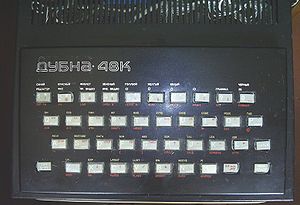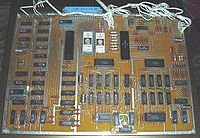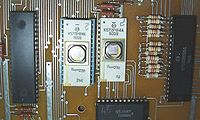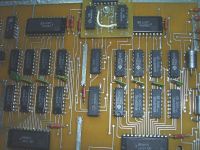- Dubna 48K
-
For other uses of "Dubna", see Dubna (disambiguation).
Dubna 48K 
Release date 1991 Operating system Sinclair BASIC CPU analogue of Zilog Z80 @ 1.875 MHz Memory 48 KB The Dubna 48K (Дубна 48К) is a Soviet clone of the ZX Spectrum home computer. It was based on an analogue of the Zilog Z80 microprocessor. Its name comes from Dubna, a town near Moscow where it was produced, and "48K" stands for 48 KBs of RAM.
According to the manual, this computer was intended for:
- studying the principles of PC operation
- various kinds of calculations
- "intellectual games"
By the time this computer was released (1991), there were already much more powerful x86 CPUs and commercially available advanced operating systems, such as Unix, DOS and Windows. The Dubna 48K had only a built-in BASIC interpreter, and loaded its programs from a cassette recorder, so evidently, it couldn't run any of modern operating systems, and as such, wasn't suitable for "studying the principles of PC operation". However, the Dubna 48K and many other Z80 clones, hopelessly outdated by that time, were largely introduced in high schools of the Soviet Union. According to a contemporary who studied at a school in Chelyabinsk in the 1980s, they used wooden plates with keyboard drawn on them[citation needed], as the schools greatly lacked PCs for computer science lessons. So even these outdated computers were considered as a great boon.
Moreover, most of the games for the Z80 were already available for Nintendo's 8-bit game console, marketed in Russia under the brand Dendy, and it was a much cheaper, more reliable and easier way of playing games, so it became clear that the Dubna 48K wasn't in much demand for home users.
Included items
The Dubna 48K was shipped with the following units:
- Main unit ("data processing unit", as stated on its back side), with mainboard and built-in keyboard
- External power unit
- Video adapter for connecting the computer to the TV set
- BASIC programming manual
- Reference book, including complete schematic circuit
Additionally, there were some optional items:
- Joystick
- 32 cm (12") colour monitor
The computer could also connect to a ZX Microdrive, but such device was never included.
Technical Details
- CPU: 1.875 MHz, 8-bit
- RAM: 48 KB (in 16 KR565-series chips, see picture 4)
- ROM: 16 KB (picture 3, two white chips in the middle)
- Resolution: 256×192 pixels, or 24 rows of 32 characters each
- Number of colours: 8 colours in either normal or bright mode, which gives 15 shades (black is the same in both modes)
- RS-232 port
- Power unit: 5V, 1.7 A
- Dimensions of main unit: 52×320×255
See also
Sinclair Research 
Timex Sinclair Amstrad ZX Spectrum +2 · ZX Spectrum +3Cambridge Computer Compatible systems Jupiter Ace · SAM Coupé · Didaktik · Dubna 48K · Hobbit · Pentagon · Scorpion · Sprinter · One Per Desk · CST Thor · Q40/Q60 · Komputer 2086Sinclair Research Peripherals Timex Peripherals List of Soviet computer systems A • Agat • Aragats • Argon • ATM Turbo • BESM • Besta • Dnepr • Dubna 48K • Elbrus • UKNC • DVK • Elektronika BK • Elektronika 60 • Electronika 85 • Electronika SS BIS • Electronica MC 1502 • Electronica MC 1504 • ES EVM • ES PEVM • GVS-100 • Hobbit • Iskra • Irisha • Kiev • KVM-1 • Korvet • M-1 • M • MESM • Micro-80 • Microsha • Minsk • MIR • Nairi • Orion-128 • Pentagon • Poisk • Promin • PS-2000, PS-3000 • Razdan • Radon • Radio-86RK • Scorpion • Setun • SM EVM • Sneg • Specialist • Strela • SVS • TsUM-1 • UM • Ural • Vector-06C • VesnaCategories:- Soviet computer systems
- ZX Spectrum clones
- Soviet Union–United Kingdom relations
Wikimedia Foundation. 2010.



